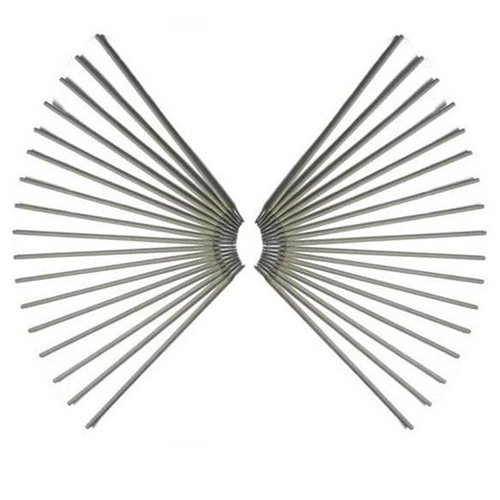CHARACTERISTICS & APPLICATIONS
ímet-11018M(H4R) are iron powder, low hydrogen electrodes originally designed for military applications such as welding HY80 and HY100 type steels. To achieve desired weld metal properties and soundness, these electrodes have small alloy additions (especially some Ni) and require careful control of moisture in the electrode covering. It is important that moisture levels in the coating be maintained during electrode manufacture, packaging, transport, and site storage.
These electrodes are usually employed without subsequent post weld heat treatment. However, hydrogen-release treatments at lower temperatures, typically less than 260°C, are often applied. In the as-welded condition, the weld-metal mechanical properties include ultimate tensile strength minima of 760 MPa and good notch toughness at temperatures at –50°C. With these properties, the E11018M type electrodes are suitable for joining many high-strength, low-alloy, or micro alloyed steels such as ASTM A514, A517, A543 Type B or C; NAVSEA Technical Publication T9074-BD-GIB–010/0300 K31820, K32045 HY80 or HY100, UNS Nr. K11630,
K42339 to themselves or to lower strength steels, including carbon steels.
These electrodes are intended to be like types of electrodes covered by military specifications MIL-E–22200/1 and MIL-E– 22200/10.
Storage and Drying Conditions: Not recommended | Ambient temperature (For R-Class)
Hydrogen can have adverse effects on welds in some steels under certain conditions. One source of this hydrogen is moisture in the electrode coverings. For this reason, the proper storage, treatment, and handling of electrodes are necessary.
Holding Ovens: 125°C–150°C Drying Conditions: 250°C–425°C
CHEMICAL COMPOSITION OF UNDILUTED WELD
|
C |
Mn | Si | P | S | Ni | Cr | Mo |
Additional Elements |
|
0.10 |
1.30-1.80 | 0.60 | 0.03 | 0.03 | 1.25-2.50 | 0.40 | 0.25-0.50 |
V=0.05 |
Single values are maxima, except where specified otherwise.
ALL-WELD-METAL MECHANICAL PROPERTIES (AW)
Preheat and Interpass : 95 to 110°C | Post weld Heat Treatment : NS°C for 1 Hour(s) The temperature shall be raised at the rate of 85°C to 280°C per hour and allowed to cool at a rate not greater than 200°C per hour, and may be removed from the furnace when the temperature of the furnace has reached 300°C and allowed to cool in still air.
|
Tensile Strength, MPa |
Yield Strength, At 0.2% Offset, MPa | Elongation % |
Charpy V-Notch Impact at -50°C, Joules |
|
760 |
680-760 | 20 |
27 |
Single values are minimal.
For 2.5 mm electrodes, the upper value for the yield strength may be 35 MPa higher than the indicated value. Impact test specimens are tested without thermal treatment.
Limit of Moisture Content, % by weight max: 0.15 max (Reconditioned) | 0.40 (As Exposed) for H4 version Diffusible Hydrogen Content Average, Maximum, mL(H2)/100 g Deposited Metal: 4.00
Welding Considerations
Preheat and interpass minimum temperatures also have a significant effect on the strength levels attained with certain low-alloy steel weld metals. These weld metals are affected by rapid cooling rates which tend to produce more martensitic or bainitic microstructures. These microstructures will often exhibit higher yield and tensile strengths with a decrease in ductility.
The cooling rate can be retarded by utilizing a higher preheat and interpass temperature. The preheat and interpass temperature ranges given herein are adequate for the preparation of the test assemblies.
However, in actual production, users are encouraged to test their own procedures to verify that they have selected preheat and interpass temperatures which will produce desirable results in production. Heat input will have a significant effect on the strength levels attained in many of the higher strength weld metals produced from the electrode classifications in this specification. For instance, weld metal produced with E11018M [E7618M] electrode at a 1.38 kJ/mm heat input may exceed 760 MPa yield strength in the as-welded condition and 680 MPa yield strength after post weld heat treatment. On the other hand, if the heat input is raised to 2.17 kJ/mm, this same electrode will produce weld metal that does not go above 760 MPa in as-welded yield strength and after post weld heat treatment may be below 680 MPa yield strength.
It is, therefore, recommended that, if the user is going to use either lower or higher heat inputs than normally used for classification testing of electrodes, the user should test the welding procedure to be used to determine that the strength levels expected will be attained in production. This is especially true if out-of-position welding is to be performed.
Due to the thick covering and deep cup produced at the arcing end of the electrode, iron powder electrodes can be used very effectively with a “drag” technique. This technique consists of keeping the electrode covering in contact with the work piece at all times, which makes for easy handling. However, a technique using a short arc length is preferable if the 2.5 mm or 3.2 mm electrodes are to be used in other than flat or horizontal fillet welding positions or for making groove welds.
SIZES & CURRENT CONDITIONS (DCEP)
|
DIAMETER, mm |
LENGTH, mm |
Amperes |
|
2.50 |
350 | 70-100 |
| 3.15, 3.20 | 350 |
115-155 |
|
4.00 |
350, 450 | 135-185 |
| 5.00 | 450 |
200-275 |
NOTE: H4 R variant is available for supply on request.
WARNING: Safety and health information is available from many sources, including, but not limited to Safety and Health Fact Sheets listed in A11.3, ANSI Z49.1 Safety in Welding, Cutting, and Allied Processes published by the American Welding Society, 8669 Doral Blvd., Suite 130, Doral, FL 33166., and applicable federal and state regulations. The Safety and Health Fact Sheets are revised, and additional sheets added periodically.

